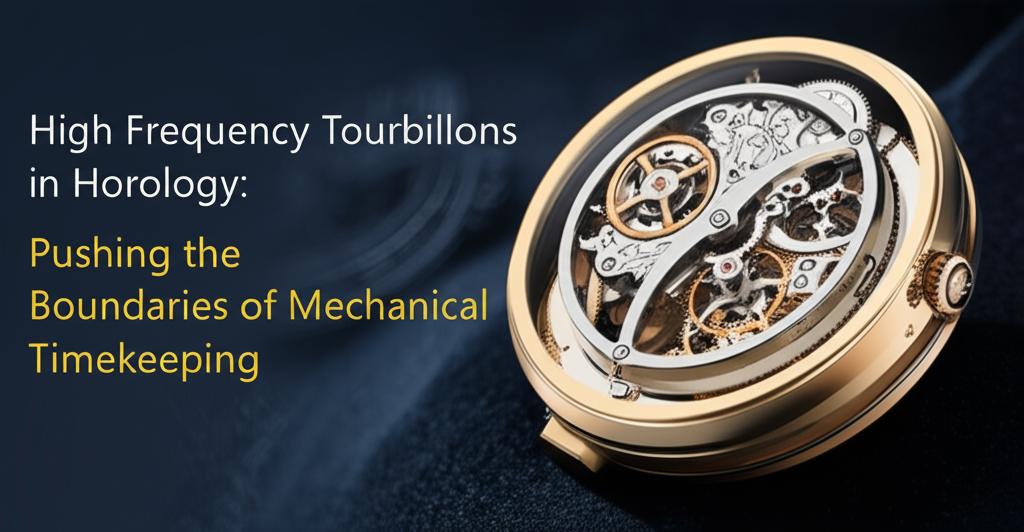The relentless pursuit of chronometric perfection has led horology into the fascinating realm of high-frequency tourbillons. This intricate combination of a gravity-defying mechanism with rapid oscillations represents a significant step in pushing the boundaries of mechanical timekeeping.
Understanding Frequency and the TourbillonIn mechanical watches, frequency refers to the number of oscillations the balance wheel makes, typically measured in Hertz (Hz) or vibrations per hour (vph). A higher frequency generally translates to greater precision. This is because a faster-beating balance wheel is more stable, less susceptible to external disturbances like shocks or magnetic fields, and can recover more quickly from them. Standard watch frequencies range from 2.5 Hz (18,000 vph) to 4 Hz (28,800 vph), with movements at 5 Hz (36,000 vph) or above considered "high-beat."
The tourbillon, invented by Abraham-Louis Breguet in 1801, was designed to counteract the effects of gravity on the watch's regulating organs (balance wheel, hairspring, and escapement) when a watch, typically a pocket watch, remained in a static vertical position for extended periods. It achieves this by housing these components in a rotating cage, which completes a full revolution typically once per minute, thus averaging out positional errors. While the practical necessity of the tourbillon in wristwatches (which are constantly in motion) is debatable, it remains a celebrated display of horological mastery.
The Synergy of High Frequency and TourbillonsCombining a high-frequency escapement with a tourbillon aims to achieve an even higher degree of precision and rate stability. The rapid oscillations of a high-beat movement enhance the tourbillon's ability to compensate for gravitational effects and resist external perturbations.
Innovations and Leading ExamplesSeveral watchmakers have been at the forefront of developing high-frequency tourbillons:
- TAG Heuer: Known for its avant-garde approach, TAG Heuer introduced the Mikrotourbillons in 2012, a concept watch with a dual tourbillon design. One tourbillon, operating at an impressive 50 Hz (360,000 vph), rotated every five seconds and enabled a chronograph accurate to 1/100th of a second. More recently, in 2023, they unveiled the TAG Heuer Carrera Chronograph Tourbillon with a more classic aesthetic.
- Zenith: Famous for its El Primero high-frequency chronograph movement, Zenith has also incorporated high-frequency tourbillons into its collections. The Zenith Defy Inventor boasts an 18 Hz (129,600 vph) movement. In 2024, Zenith introduced the Defy Skyline Tourbillon, featuring a new El Primero 3630 automatic high-frequency (5Hz or 36,000 vph) tourbillon movement in steel and black ceramic cases.
- Grand Seiko: In 2020, Grand Seiko unveiled the T0 Constant-Force Tourbillon as a concept movement, the world's first to integrate a constant-force mechanism and a tourbillon on the same axis. This was later adapted into the Kodo "Heartbeat" wristwatch in 2022. While its frequency is 28,800 vph (4 Hz), the integration of the constant-force mechanism with the tourbillon is a significant innovation aimed at achieving supreme accuracy.
- Jacob & Co.: Pushing boundaries in complexity, Jacob & Co. recently announced the Astronomia Revolution Four-Axis Tourbillon. This timepiece features a triple-axis flying tourbillon on a rotating carousel (effectively a fourth axis) and is kept in motion by a high-frequency constant force system to manage the dizzying rotation speeds of its axes (60, 18, 15, and 60 seconds respectively).
- Chopard: The Chopard Alpine Eagle collection has featured high-frequency calibers and, since 2022, a flying tourbillon. Their L.U.C 96.24-L movement, powering a new Alpine Eagle Flying Tourbillon, is remarkably thin at 3.3mm. Chopard is notable for having its flying tourbillon watches certified as both Chronometer and Poinçon de Genève. The Alpine Eagle Cadence 8HF models also showcase high-frequency movements.
- Girard-Perregaux: With a history of innovation including the first high-frequency caliber (Gyromatic HF at 5 Hz) in the 1960s, Girard-Perregaux continues to explore advanced mechanisms and materials like Carbon Glass and ceramic in their tourbillon watches.
The development of high-frequency tourbillons is not without its challenges:
- Increased Wear and Tear: Higher frequencies mean more movement and friction between components, potentially leading to faster wear and requiring more frequent maintenance and robust lubrication.
- Power Reserve: High-beat movements generally consume more energy, which can impact the power reserve. Manufacturers often address this by incorporating solutions like double barrels.
- Material Science: Components in high-frequency escapements need to be lightweight yet highly wear-resistant. The use of advanced materials like silicon and ceramicized titanium has become crucial.
- Complexity and Cost: The intricate nature of both tourbillons and high-frequency movements means that their combination results in highly complex and typically very expensive timepieces.
Despite the challenges, the allure of pushing mechanical precision to its limits continues to drive innovation. Watchmakers are constantly exploring new materials, escapement designs, and tourbillon configurations. The quest for higher frequencies, coupled with the captivating visual ballet of the tourbillon, ensures that this specialized field of horology will continue to see remarkable advancements, offering enthusiasts and collectors timepieces that are both technical marvels and works of art. While some argue that the practical benefits of a tourbillon in a wristwatch are minimal due to modern movement adjustments and the wrist's constant motion, the combination with high-frequency oscillators undeniable enhances the inherent stability and precision of the regulating organ.

